There is no doubt that Pelicans are amazing and unique birds. They are the only birds in the world with a huge pouch hanging below their bills. And this is just the beginning of what makes them special. In this article, you will meet the 8 pelican species of the world and learn a little about each.
1. American White Pelican
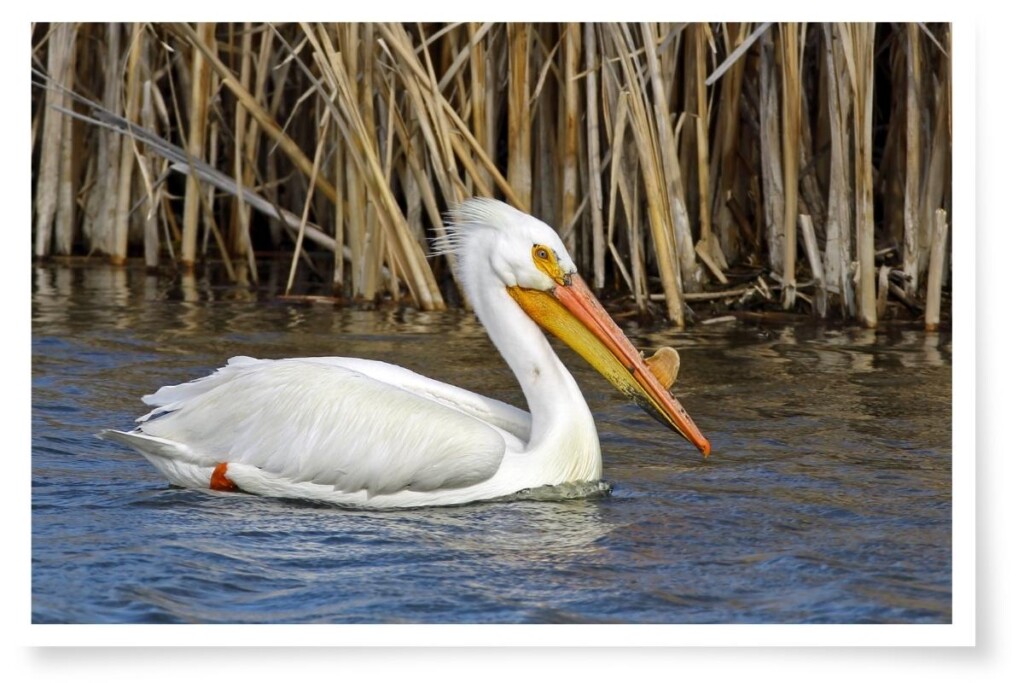
Where Are They Found?
American White Pelicans occur mostly in Western and Southern parts of North America. They forage on inland lakes, marshes, or rivers and favor shallow waters.
They can also be found in parts of Central America, as you can see in the map below.

Size And Color
Body length: 127-165 cm (4.2-5.4 ft).
Bill length: Male average 34.2 cm (13.5 in.).
Females average 28.8 cm (11.3 in.).
Wingspan: 244-290 cm (8-9.5 ft).
Mostly white with black ends on their wings. During the breeding season, the males develop a horn on their bills, their bills and legs turn bright orange, and they also develop white plumes on the back of their heads.

How Much Do They Weigh?
Most birds of this species are around 4.54-7.72 kg (10-17 lbs) though they have been recorded up to 13.6 kg (30 lbs).
How Long Do Pelicans Live? Find out in this post.
2. Brown Pelican

Where Are They Found?
Brown Pelicans live year-round in the coastal regions from Central North America to Northern South America.
They inhabit warm coastal waters and estuaries.
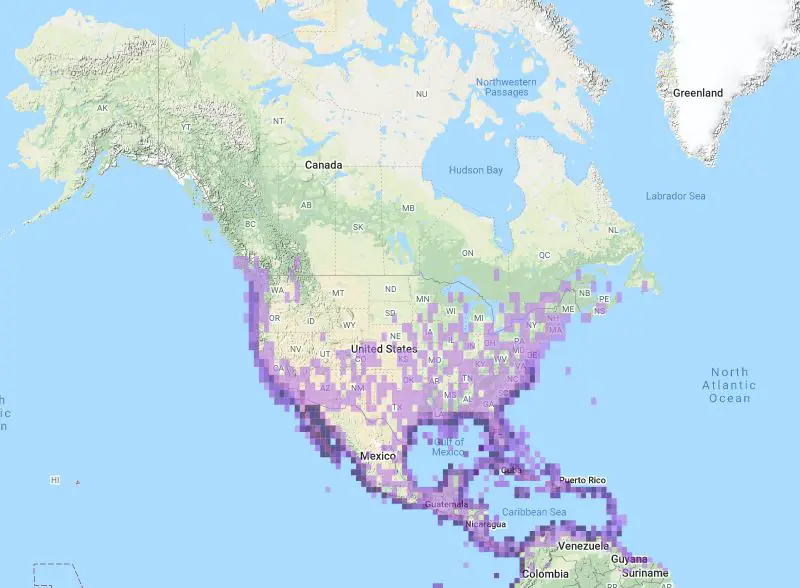
Size And Color
Body length: 100-137 cm (3.3-4.5 ft).
Bill length: 25–38 cm (9.8-15 in.). Around 10% longer in males than females.
Wingspan: 2 m (6.5 ft).
They are very striking birds with gray to gray-brown upper parts, and black-brown bellies. The remainder of their underparts are striped with black and silver.
Their heads and necks can appear different depending on the time of year. During the post-breeding season, their heads are pale yellow and their necks are white.

Just prior to breeding their neck will become dark brown while their head remains yellow. When nesting, their heads appear white (sometimes speckled with dark feathers) and their necks are brown.
How Much Do They Weigh?
Male Brown Pelicans range from 2.4 to 4.0 kg (5.3-8.8 lbs), averaging around 3.3 kg (7.3 lbs). Females weigh within 1.8 to 4.0 kg (4-8.8 lbs) with an average weight of around 2.8 kg (6.2 lbs).
Check out some unusual birds that will shock you in this article here on the blog.
3. Peruvian Pelican

Where Are They Found?
Peruvian Pelicans, as their name suggests, are found in coastal regions from Northern Equador to Southern Chile in South America.

Size And Color
Body length: 137-152 cm (4.5-5 ft).
Bill length: No information available.
Wingspan: 228 cm (7.5 ft).
These are really stunning pelicans. They are similar to the brown pelican and were in fact once thought to be a sub-species of the brown.
Mostly dark brown-gray speckled with silvery-gray. They are cream-colored on their heads and this shade continues down around the base of their pouches.

Their facial skin is black, often with a warty section on the forehead. Their bills are straw-yellow and have vibrant red strips. As you can see in the above image, during the breeding season, their pouches are a powdery blue color. They are one of the more colorful pelican species of the world.
How Much Do They Weigh?
Peruvian pelicans weigh between 5 and 7 kg (11-15 lbs).
Ever wondered what birds do for fun? Find out in this article.
4. Great White Pelican
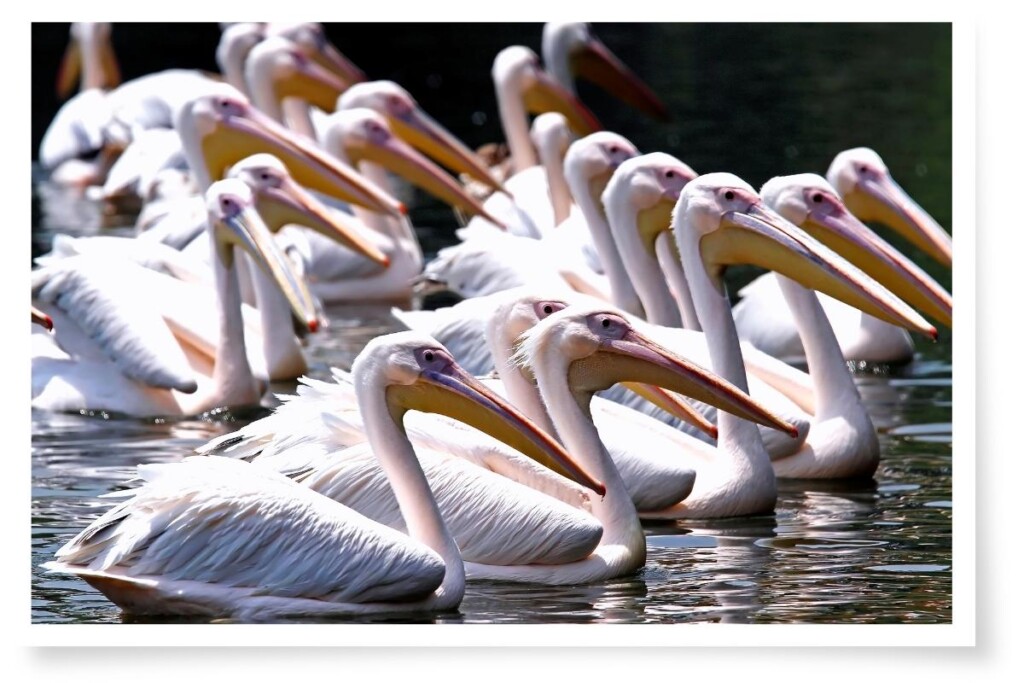
Where Are They Found?
Great White Pelicans occupy a very wide and sparse range across Europe and Africa.
They breed from southeast Europe to north and southeast Kazakhstan, and also in Africa south of the Saraha Desert. They spend their winters in northeast Africa, southern Iraq, northern India, and western Myanmar.

In Europe and Asia, these birds prefer fresh or brackish lakes, lagoons, and marshes with large reedbeds in which they can breed. They will frequent alkaline or freshwater lakes, even marine lakes in Africa.
In western Africa, great white pelicans will breed on kopjes (inselbergs) like the one below:

Size And Color
Body length: 140-170 cm (4.6-5.6 ft).
Bill length: 28.9-40 cm (11.4-15.7 in.).
Wingspan: 226–360 cm (7.4-11.8 ft).
Great white pelicans are big birds?! They are the second-largest pelican species in the world behind the Dalmation Pelican which we will look at later in the article.

As their name suggests, great white pelicans are mostly white. Adult birds will have a faint pink tinge on their necks and other parts. The base of their foreneck has a yellow tinge.
Adult birds develop a swollen bulge on their foreheads. Their gular pouches are cream-yellow to yolk-yellow.
Their flight feathers are black as seen in the image above.
Juvenile great white pelicans have darker, brownish upper parts:

How Much Do They Weigh?
Male great white pelicans can weigh anywhere between 9 and 15 kg (19.8-33 lbs). Female birds are lighter, weighing between 5.4-9 kg (11.9-19.8 lbs).
5. Australian Pelican

Where Are They Found?
Australian Pelicans have a huge range. They are found across most of mainland Australia and Tasmania in both coastal and inland areas. They also visit New Guinea, the Solomon Islands, and Indonesia.
These birds are even found in New Zealand, over 4000 km (2500 mi.) from Australia.

They prefer large stretches of open water without dense vegetation. You will find them on large lakes, reservoirs, billabongs (a branch of a river forming a backwater or stagnant pool), rivers, estuaries, swamps, temporarily flooded areas, drainage channels, saltpans, coastal lagoons, and fishing ports.
Australian pelicans nest on small sandy islands or along the shore of the ocean, lakes, swamps, etc.
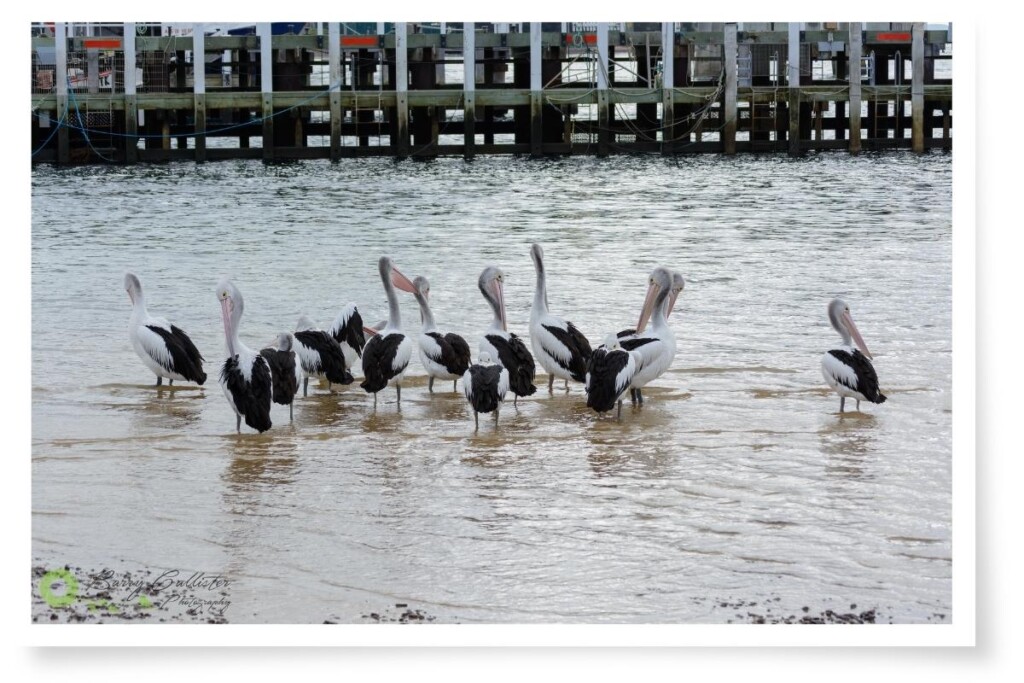
Discover other fish-eating Australian birds in this post here on the site.
Size And Color
Body length: 152–188 cm (5-6.2 ft).
Bill length: Male – 40.9-50 cm (16.1-19.7 in.).
Female – 34.6-40.8 cm (13.6-16.1 in.).
Wingspan: 230–260 cm (7.5-8.5 ft).
Breeding adult Australian pelicans have mainly white heads and upper parts. There is a grey tinge on the feathers on the nape of their necks and upper hindnecks which form a kind of mane.

Their wings are white at the shoulder and black towards the outer edges. Their backs and tails are also black.
These are the only pelican species of the world in which the bare skin around the eyes does not reach the base of the bill. As you can see in the image above, this patch of skin on the Australian pelican is a rich yellow color. There is also a yellow tinge on their gular pouch.
How Much Do They Weigh?
The Australian pelican weighs in between 4 and 6.8 kg (8.8-15 lbs).
6. Pink-backed Pelican
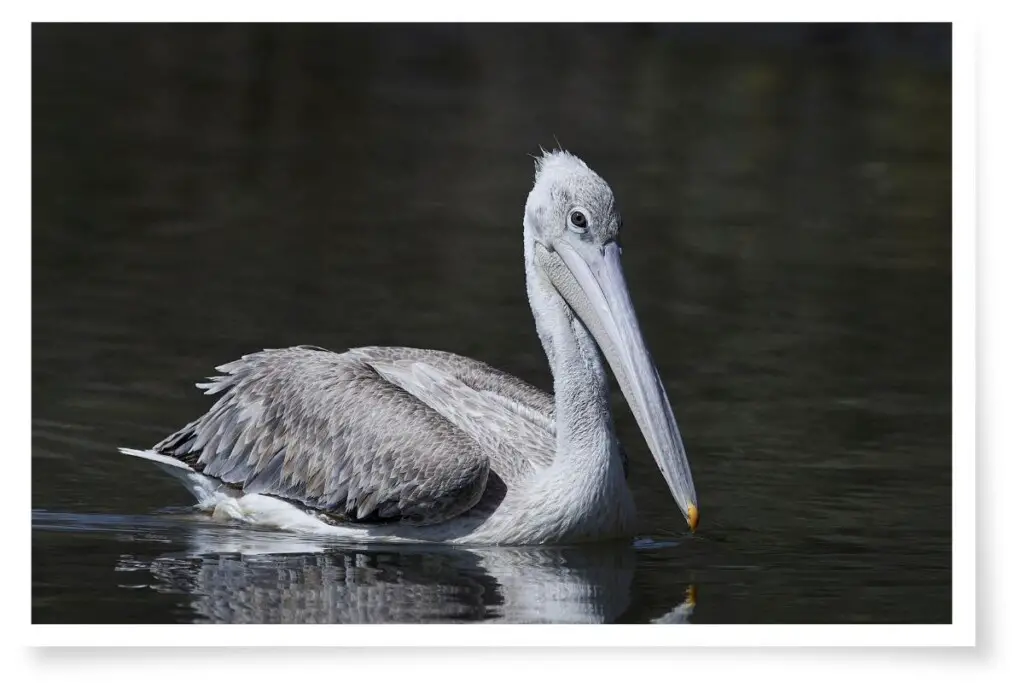
Where Are They Found?
Pinked-backed pelicans are found in tropical and subtropical Africa from Senegal east to Sudan and Somalia, and south to northern South Africa and Namibia. They’re also found in southwest Arabia and in small numbers in the southeast of Egypt.

These pelicans are not fussy about where they live; freshwater lakes, swamps, rivers, seasonal ponds, bays, and alkaline lakes. They even frequent dry country when locusts are abundant.
Pink-backed pelicans breed in trees, on sandy islands, in mangroves, and sometimes near populated areas.

Size And Color
Body length: 125–132 cm (4.1-4.3 ft).
Bill length: 29–38 cm (11.4-15 in.).
Wingspan: 216–290 cm (7.1-9.5 ft).
A pink-backed pelican’s feathers are mostly white mixed with a grayish shade. The feathers on the nape of their necks are mostly gray and form a shaggy crest. The base of their forenecks and chests are slightly tinged with pale yellow, or a dull pink tinge, especially on their flanks and back.

Their wing feathers are gray to blackish with silver-gray to whitish fringes.
How Much Do They Weigh?
Pink-backed pelicans tip the scales at around 3.9 to 7 kg (8.6-15.4 lbs).
7. Spot-billed Pelican

Where Are They Found?
The spot-billed pelican breeds in west, south, and east India, Sri Lanka, Cambodia, and possibly Sumatra. When not breeding, they can be found in Nepal, Myanmar, Thailand, Laos, and Vietnam. Their range is much reduced from what it used to be.

Spot-billed pelicans prefer marshes, jheels (in India: a pool, lake, or marsh remaining from inundation), rivers, estuaries, reservoirs, tanks, flooded fields, large lakes, brackish lagoons, and tidal creeks. They will often feed in quiet backwaters along the coast.
These birds nest in large trees, often with other species including Painted Storks:

Size And Color
Body length: 127–152 cm (4.2-5 ft).
Bill length: 28.5–35.5 cm (11.2-14 in.).
Wingspan: 213–250 cm (7-8.2 ft).
Spot-billed pelicans have dull white heads and necks that can be somewhat grizzled (streaked with gray) or peppered. They have brown-gray manes on the backs of their necks and the backs and sides of their rumps can be tinged with dull pink or salmon pink.

Their gular pouches are pink to purplish and have large pale spots which also appear on the upper bill. When in breeding plumage, the skin at the base of the bill is dark and the patch of skin around their eyes is pink.
As with all pelican species of the world, their wing feathers are darker at the outer tips, appearing dark gray or blackish.
How Much Do They Weigh?
Spot-billed pelicans, smaller than other pelicans, also weigh less, coming in at around 5.1-5.7 kg (11.2-12.6 lbs).
8. Dalmatian Pelican
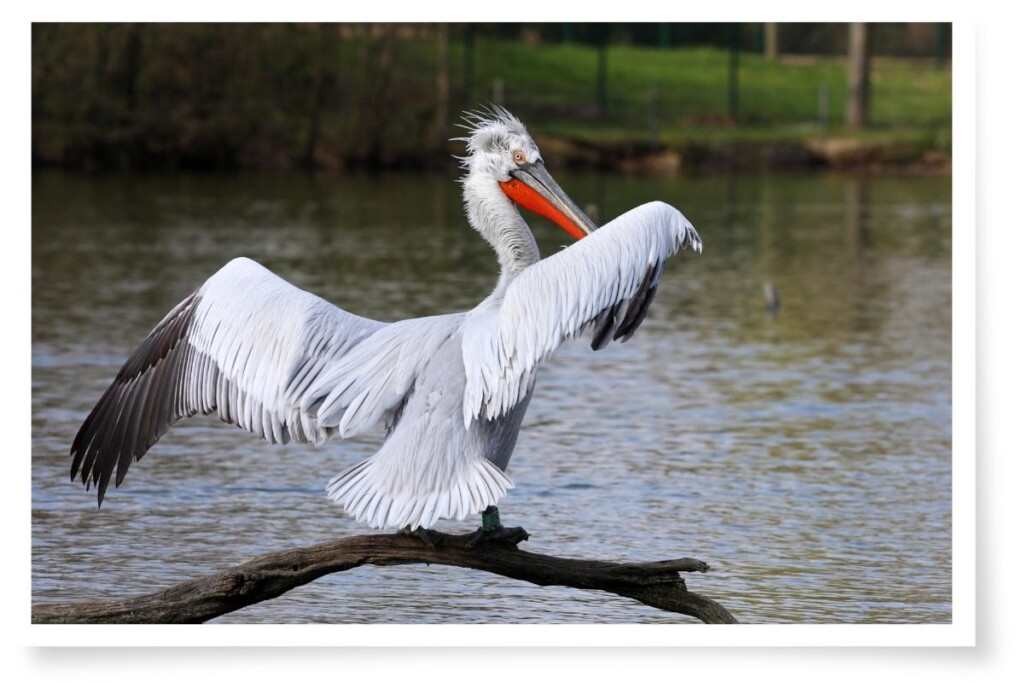
Where Are They Found?
The range of the dalmatian pelican spreads across Europe and Asia. They breed in southeastern Europe; Serbia and Montenegro down to Greece and also in southern Ukraine and southern Russia. In Asia, they breed from Kazakhstan west to Mongolia, and in the south in western and northeastern Turkey, Azerbaijan, Iran, and western China.

They winter mostly in the eastern Mediterranean region; birds from Russia and Central Asia migrate to southern Iran, southern Iraq, and the Indian subcontinent, and breeding birds from Mongolia move to eastern China.
Dalmatian pelicans like rivers, lakes, deltas, and estuaries. When nesting, they prefer islands or areas of dense aquatic vegetation.

Size And Color
Body length: 160–180 cm (5.2-5.9 ft).
Bill length: 37–45 cm (14.6-17.7 in.).
Wingspan: 310–345 cm (10.2-11.3 ft). That is one BIG bird?!
Dalmatian pelicans are the largest of all pelicans and have a rebellious head of hair (well, feathers) to match.
Their upper parts and tails are chalky white, and the feathers on their heads and necks appear grizzled due to their gray bases being exposed. The feathers on the back of their necks and heads are long and curly, giving them a hair-like appearance which is obviously what earned these birds the name dalmatian pelican.

In keeping with the other pelican species, these birds have black fringing on their wings. Underneath their wings are pale gray bleeding to black at the edges.
The underparts of a dalmatian pelican are chalky white and their lower necks and chests have a cream-yellow to ochraceous tinge.
During the breeding season, the gular pouch of male birds turns a bright reddish-orange color.
How Much Do They Weigh?
Being the largest pelican, dalmatians are also the heaviest at around 10–13 kg (22-28.7 lbs). This weight earns them a place in the world’s top 10 heaviest flying birds.
References
- Birds Of The World – The Cornell Lab Of Ornithology
- Additional plumage information – Wikipedia
- 11 Heaviest Flying Birds in the World – World Birds
